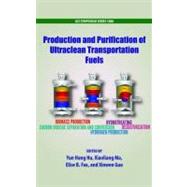Production and Purification of Ultraclean Transportation Fuels
, by Hu, Yun Hang; Ma, Xiaoliang; Fox, Elise; Guo, Xinwen- ISBN: 9780841226937 | 0841226938
- Cover: Hardcover
- Copyright: 6/7/2012
As the global climate changes, scientists anticipate that the distribution of animal populations and disease vectors will expand. In the case of arthropods, such efforts hold immense significance as they have the potential to increase human mortality and suffering from arboviruses abovecurrent levels. The 238th American Chemical Society National Meeting and Exposition in Washington, D.C. on August 16-20, 2009, offered an opportunity for researchers to present and discuss new findings in invertebrate repellents research, regulations, and technology development.Recently efforts have been made to understand the role of chemicals in arthropod behavior, and screening programs are starting to incorporate repellency testing into their battery of bioassays. The lack of standardized protocols for measuring and comparison of repellents has remained a significantobstacle in arthropod research. Oftentimes studies report variable measures of success, and comparison of results across studies is not always consistent. Progress in the standardization of arthropod test methods for repellents would be valuable to many groups including academic researchers workingin the field, contract labs supplying test results, government research laboratories, regulatory bodies in the process of developing guidelines for product registration, as well as companies looking to invest in new technologies. Perhaps one complicating factor in this process has been that researchand technology haven't moved fast enough to meet the demand for effective arthropod repellents. Issues such as pest arthropod resurgence and insecticide/repellent resistance to chemical can create new challenges and add pressure for researchers.The collection of chapters in this book covers a range of applied and basic research on arthropod repellents. An overview of the state of arthropod repellents research is provided at the start. In the chapters that follow, there is a selection of papers demonstrating research on new repellenttechnologies at different stages of development. The scope of basic and applied research methods described in these chapters on new repellent technologies presents the range of testing that is often necessary to move a repellent technology forward in development. The transition from newly developedtechnologies to registered products is achieved in perspective of a growing market for natural arthropod repellents. New technologies that are completely developed and have gone through registration need to be accompanied by successful commercialization. The growing market for natural arthropodrepellents presents such an example and highlights new opportunities in this area. The concluding chapter discusses the public entomology landscape, past and future opportunities for the development of chemical protectants.







